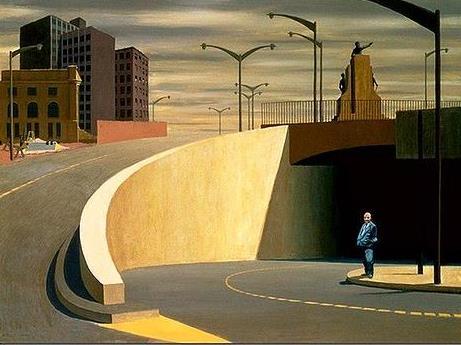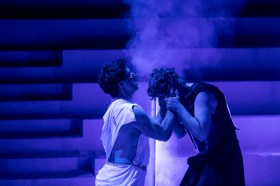Jeffrey Smart’s Cahill Expressway (1962)
Last Friday morning, at the National Gallery of Australia in Canberra, a large crowd gathered to attend a memorial service for the artist, Jeffrey Smart AO, who died earlier this year. Hosted by Director, Ron Radford AM, the Governor-General led the personal, affectionate, respectful and witty tributes to a man who lived life well and whose significant body of paintings will continue to reveal to generations the mysteriousness of his portrayals of familiar and mundane urban landscapes.
A few days earlier, when it was announced in Sydney that Fiona Hall AO is to represent Australia at the Venice Biennale in 2015, the enthusiastic reaction from a wide number of people reflected strong support for the appointment and excitement for the possibilities of her collaboration with curator, Linda Michael.
Continuing through to the middle of December in Melbourne, The Ring Cycle performed by Opera Australia has received accolades for the powerfully dramatic and beautifully performed telling of the story. Of particular note has been the way Neil Armfield AO has created a strong Australian production with many of the most talented in the nation involved in every aspect of the epic.
In each of these instances, there is a palpable respect shown for the artist and those engaged directly in the creative process. They are being acknowledged as a potent and vital life force in the cultural life of the country. Along with high visibility events showcasing musicians, the film and television industry, writers and the performing arts, these are some of the occasions when Australian artists are given profile and status.
If we are to succeed as a culturally ambitious nation, these and other forms of recognition, encouragement and respect are central to that quest. Our artists apply their talents and skills, often accumulated over long careers, to create images or performances that bring us insight, pleasure and even disruption. Often, they cause us to stop and reconsider our own lives as well as the lives of others. Occasionally, they challenge our views of our nation and its place in the world. The role that artists perform benefits each of us.
However, these examples aside, other than a short-lived resurgence of interest at the time of death, appropriate public acknowledgment of artists is uneven, unpredictable and uncertain. During their working lives, even though a few may be recognised through our Honours system, many Australian artists are not just unrecognised but are often targets for a form of ‘sledging’ that we usually associate with the sporting arena.
While the latter may be psychological warfare designed to put an opponent off his or her game, with artists the purpose seems to be to be to question their role, belittle their talent, censor their inventiveness or curb their imagination. In other more subtle savagery, the raw talent and ability of those artists that eschew publicity or choose not to embrace the arts media are overlooked.
In the commentary around the Royal Academy’s Australia exhibition, while the brutality of a couple of critics who didn’t like the show succeeded in capturing our attention, over 40 contemporary artists had their work on display at one of the great venues of the world and many of them were present to be honoured at a dinner following the opening in the Academy’s Joshua Reynolds room.
This respect shown to these artists and the curators responsible for the exhibition, the many favourable reviews and the reality of long queues of visitors to the triumphant exhibition should eliminate the cowering and apologetic attitude that some curiously expected us to adopt.
On her launch in May in Canberra, Patricia Piccinini’s Skywhale was greeted with hostility by a sceptical media. The work and the artist were pilloried and mocked by commentators who probably knew better but did it anyway. Just as the arts sector started to rise to say “enough, you’ve had your fun: now grow up”, an interesting phenomenon occurred. Led by children and young people, the public became enchanted by the work and the media were stranded on the wrong side of the argument, looking dated and out of touch.
As is the case in any profession, the respect that matters most to an artist is that of his or her peers. For artists, that often comes along before a wider public appreciation of their work. Too often the latter is too late, when we have missed the opportunity to join in its expression. A memorial service is a fine place to show respect to an artist and award ceremonies are too. However, we will all be the beneficiaries of an attitudinal change that has more respect shown for all forms of contemporary art practice and to the living.






